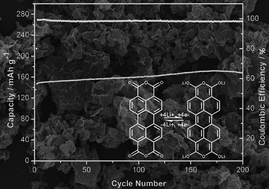Graphene wrapped 3,4,9,10-perylenetetracarboxylic dianhydride as a high-performance organic cathode for lithium ion batteries†
Abstract
Graphene wrapped 3,4,9,10-perylenetetracarboxylic dianhydride (C24H8O6) composite materials have been successfully prepared through a facile heat-treatment process at different temperatures. Benefiting from the three-dimensional conductive network provided by the densely distributed graphene nanoplates, the composite material exhibits a high reversible capacity, an excellent cycling stability and a superior rate capability. When cycled against lithium in the potential range of 1.5 to 4.6 V, the composite material prepared at 400 °C exhibited an increasing discharge capacity at 100 mA g−1 with a maximum value of 172 mA h g−1 at the 180th cycle. In addition, the material is able to deliver reversible capacities of 152, 144, 134 and 110 mA h g−1 at high current densities of 200, 300, 500 and 1000 mA g−1, respectively, with 98% of the capacity retained after 200 cycles at 500 mA g−1. The excellent electrochemical properties of the composite material make it a promising organic cathode material for large-scale lithium ion batteries.



 Please wait while we load your content...
Please wait while we load your content...